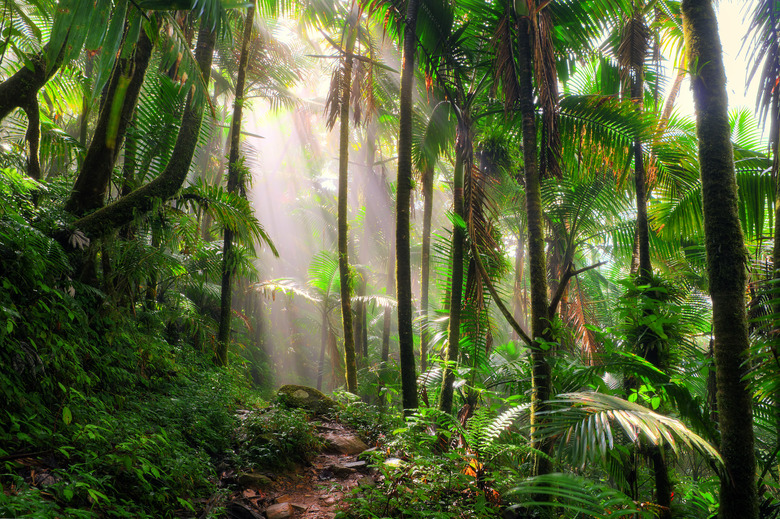Poisonous Plants In The Rain Forest
Rain forests offer some of the most amazing environments on earth. These forests, characterized by heavy rainfall and thick vegetation, provide an abundance and variety in both plant and animal life. Almost every year, scientists discover new animal and plant species in rain forests like the Amazon. The creatures living in the rain forest must deal with fierce competition from all the other living plants and animals surrounding them. Most plants and animals living in the rain forest evolved deadly adaptations to survive. As home to some of the most poisonous plants in the world, plant poisons — dispersed in multiple ways — often cause varying reactions in their victims.
TL;DR (Too Long; Didn't Read)
The world's rain forests serve as home to many poisonous plants. The poisons of these plants –dispersed in dissimilar ways — cause varying reactions in creatures affected. The stinging brush, native to northeastern Australian rain forests, uses toxic hairs to poison potential predators. The strychnine tree, native to Asian and Australian rain forests, boasts berries with seeds which contain deadly strychnine, a neurotoxin. The toxin in the curare vine's flowers are so poisonous, indigenous people coat their hunting arrows in their juice.
Stinging Brush
Stinging Brush
Stinging brush, also known as the suicide plant (Dendrocnide moroides) is a deadly plant native to the rain forests of northeast Australia. From a distance, stinging brush does not appear different from a regular berry bush. The wide leaves of the stinging brush reflect deep green colors, and its berries, offer up a bright purple, not unlike many other bushes. But on closer inspection, you may note a thin covering of translucent hairs on this plant's leaves and stems. Filled with a powerful toxin, these hairs cause immense pain to any creature that touches them. Researchers note that in some cases, the pain caused by the hairs of the stinging brush can last for months or even years. Stories tell of small animals and even people dying after encountering stringing brush.
The stinging brush's toxic hairs evolved to keep predators away. Many kinds of small animals that would normally eat the stinging brush's leaves, such as caterpillars, birds and beetles, could die if they ingested the toxic hairs. But for every living entity in the rain forest, it is almost impossible to not have a predator higher up on the food chain. Though most creatures wisely avoid the stinging brush, a few animals, like the marsupial pademelon and caterpillars of the pink underwing moth, have a natural immunity to the plant's potent toxin and readily feast on its berries and leaves.
Strychnine Tree
Strychnine Tree
As a lethal poison usually used to kill rats and other pests, strychnine became the prime agent to dispose of rats during the Bubonic Plague in Europe. But few people know that comes from a rain forest tree. The strychnine tree (Strychnos nux-vomica) is a thin-branched tree native to the rain forests of southeast Asia and Australia. This tree has green leaves, orange berries and smooth, light brown bark. Despite its normal appearance, it is one of the most toxic trees in the world.
Much of the tree's poison ends up in the seeds of its berries. As a neurotoxin, the tree's poison affects the central nervous system. Most animals die upon ingesting the strychnine tree's berries. The bark and flowers of the strychnine tree are also highly toxic. But animals like fruit bats and native rain forest beetles safely eat the fruit, leaves and flowers of this otherwise poisonous tree.
Curare Vine
Curare Vine
Native to the rain forests of Central and South America, the curare vine spreads as a thick, flowering creeper growing up the trunks of tall trees. Loaded with deadly compounds known as alkaloids, when insects and creatures eat the small, white flowers, they cause paralysis through extreme muscle relaxation. Indigenous people living in Central and South American rain forests still apply the poison to the tips of their hunting arrows, as they have for generations. When struck by these arrows, animals often collapse within seconds, depending on the animal's weight and the depth of the arrow's tip. Like most poisonous rain forest plants, the curare vine still attracts its own predators. Some caterpillars and beetles are immune to the curare vine's poison.
Poisonous rain forests plants hide their toxins in all sorts of places, from their bark to their seeds, delivering the poison in a host of ways. But most rain forest dwellers avoid these plants, except for the many creatures that evolved specific immunities to their poisons.
Cite This Article
MLA
Cook, Maria. "Poisonous Plants In The Rain Forest" sciencing.com, https://www.sciencing.com/poisonous-plants-rain-forest-8430969/. 11 April 2018.
APA
Cook, Maria. (2018, April 11). Poisonous Plants In The Rain Forest. sciencing.com. Retrieved from https://www.sciencing.com/poisonous-plants-rain-forest-8430969/
Chicago
Cook, Maria. Poisonous Plants In The Rain Forest last modified March 24, 2022. https://www.sciencing.com/poisonous-plants-rain-forest-8430969/
